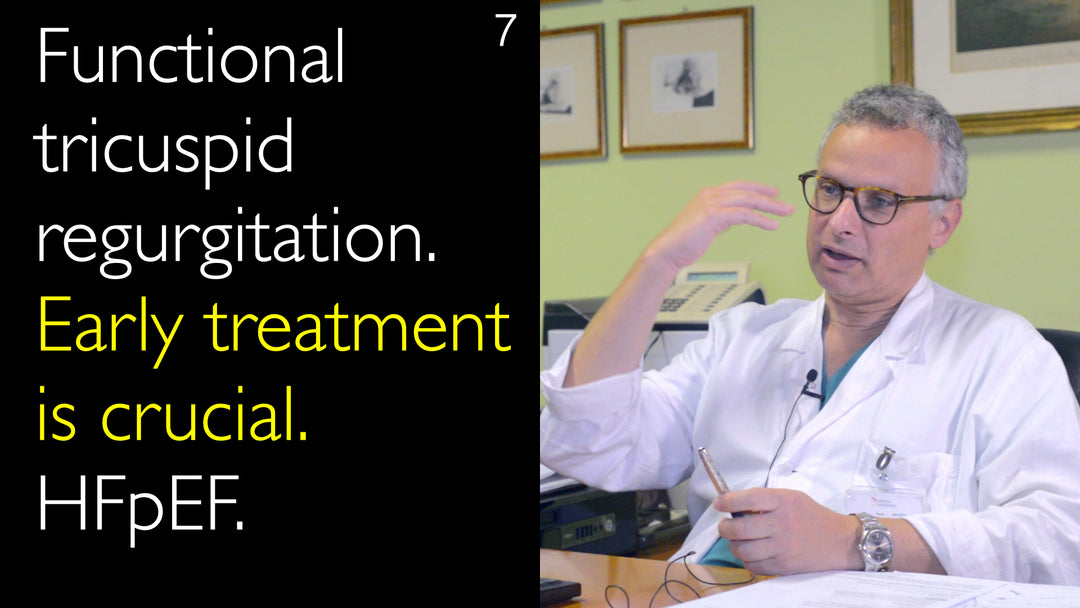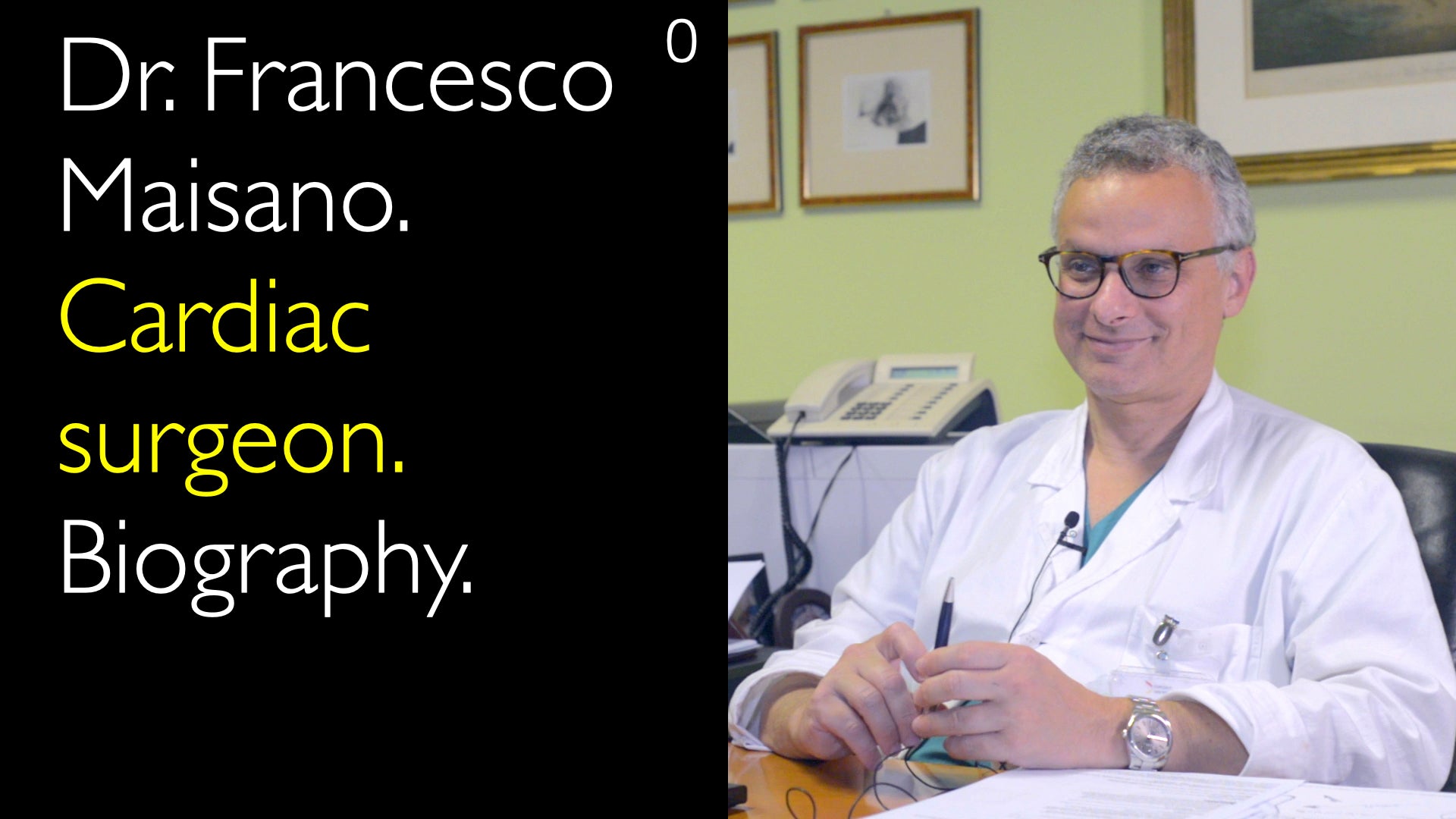מומחה מוביל בתחום מחלות המסתם התלת-צניפי, ד"ר פרנצ'סקו מייזאנו, MD, מסביר את החשיבות הקריטית של התערבות מוקדמת בדליפה תלת-צניפית תפקודית. הוא מפרט את שלושת הגורמים העיקריים לדליפה משנית ומדוע התסמינים שלה לרוב מוערכים בחסר. ד"ר מייזאנו מבהיר כי הסיכון הניתוחי גבוה רק בחולים עם אי-ספיקת איברים מתקדמת, ותומך במתן טיפול לפני התפתחות אי-ספיקת לב ימנית גלויה. הוא גם דן בקשר המשמעותי בין דליפה תלת-צניפית לאי-ספיקת לב עם מקטע פליטה שמור (HFpEF).
אבחון מוקדם וטיפול באי-ספיקת טריקוספידלית תפקודית
קפיצה לפרק
- גורמים לאי-ספיקת טריקוספידלית תפקודית
- תסמינים מוערכים בחסר של אי-ספיקה טריקוספידלית
- תפיסות מוטעות בנוגע לסיכון ניתוחי
- טיפולים חדשים מעלים שיעורי ההתערבות
- קשר בין HFpEF לאי-ספיקה טריקוספידלית
- תמליל מלא
גורמים לאי-ספיקת טריקוספידלית תפקודית
אי-ספיקה טריקוספידלית תפקודית היא מצב משני הנגרם מבעיות לב בסיסיות אחרות. ד"ר פרנצ'סקו מייסאנו, MD, מזהה שלושה גורמים עיקריים. הראשון הוא יתר לחץ דם ריאתי, העלול לנבוע ממחלות לב צד שמאל כמו אי-ספיקה מיטרלית או היצרות אבי העורקים. הגורם השני הוא תפקוד חדרי לקוי, שבו חדר מורחב, לרוב עקב מחלת לב שמאלית ממושכת, מוביל לדליפת המסתם. הגורם השלישי, המוכר יותר ויותר, הוא אי-ספיקה טריקוספידלית יאטרוגנית, הנצפית frequently בחולים עם פרפור פרוזדורים ופרוזדורים ימניים מורחבים.
תסמינים מוערכים בחסר של אי-ספיקה טריקוספידלית
התסמינים של אי-ספיקה טריקוספידלית תפקודית לרוב עדינים וקלים להחמצה. ד"ר פרנצ'סקו מייסאנו, MD, מדגיש כי many patients אינם מציגים סימנים קלאסיים של אי-ספיקת לב ימנית כמו רגליים נפוחות או מיימת. במקום זאת, הם עלולים לחוות עייפות קשה וקוצר נשימה תוך שהם נותרים אאובולימיים. הוא ממחיש זאת עם מקרה של patient whose main symptom was fatigue, caused by a critically low resting cardiac index of 1.4. תפוקת לב נמוכה זו מובילה לאי-ספיקת איברים over time, מה שהופך את הטיפול לקשה much more אם המצב אינו מטופל מוקדם.
תפיסות מוטעות בנוגע לסיכון ניתוחי
מכשול מרכזי בטיפול באי-ספיקה טריקוספידלית הוא התפיסה המוטעית שהניתוח הוא universally high-risk. ד"ר מייסאנו מבהיר שזה נכון only for patients who have developed advanced organ failure. נתוני רישום מראים שיעור תמותה כולל של around 8% לניתוח מסתם טריקוספידלי מבודד, העלול לזנק ל-50% במקרים מתקדמים. However, for patients treated early, before the onset of severe hepatic or renal dysfunction, הסיכון הניתוחי יכול להיות as low as 0%. ד"ר פרנצ'סקו מייסאנו, MD, טוען שהמתנה לסימנים גלויים של אי-ספיקת לב ימנית משמעה ניתוח when it is too late, resulting in prohibitively high mortality rates above 20%.
טיפולים חדשים מעלים שיעורי ההתערבות
הופעתן של פרוצדורות endovascular פחות פולשניות משנה את נוף הטיפול באי-ספיקה טריקוספידלית. ד"ר פרנצ'סקו מייסאנו, MD, מציין שהתערבויות בטוחות more these are leading to earlier patient referrals. זה מעלה the overall number of candidates לטיפול במסתם הטריקוספידלי, both surgical and transcatheter. He predicts a significant global rise in intervention rates as the medical community recognizes that severe TR carries a prognostic impact as serious as mitral regurgitation. שינוי זה crucial because it allows treatment before patients cross the threshold into irreversible organ failure.
קשר בין HFpEF לאי-ספיקה טריקוספידלית
קיים קשר חזק בין אי-ספיקת לב עם מקטע פליטה שמור (heart failure with preserved ejection fraction - HFpEF) להתפתחות אי-ספיקה טריקוספידלית מבודדת. ד"ר פרנצ'סקו מייסאנו, MD, מסביר that HFpEF patients often have diastolic issues, hypertension, and atrial fibrillation—all classic conditions associated with TR. אוכלוסיית חולים זו, frequently female, היא קבוצה מרכזית שבה התערבויות טריקוספידליות could play a vital role. He also highlights low-flow, low-gradient aortic stenosis as another condition where severe TR may be a hidden culprit behind reduced cardiac output. In any low-flow state, evaluating the tricuspid valve is essential, as right-sided heart failure does not cause pulmonary edema, allowing symptoms to remain deceptively mild until advanced stages.
תמליל מלא
ד"ר אנטון טיטוב, MD: מחלת מסתם טריקוספידלי פוגעת ב-1.6 מיליון patients בארצות הברית, אך only 8,000 מהם undergo ניתוח מסתם טריקוספידלי annually. You wrote about that in one of your reviews. Historically, there have been very few therapy options for tricuspid regurgitation, but the prognosis in functional tricuspid regurgitation historically has been quite poor. What are the main causes of functional tricuspid valve regurgitation?
ד"ר פרנצ'סקו מייסאנו, MD: אי-ספיקת מסתם טריקוספידלי תפקודית היא, first of all, מחלה המאובחנת more and more often. There is more attention and multiple reasons for a better diagnosis of tricuspid regurgitation. In principle, when we talk about "functional" tricuspid regurgitation, it means "secondary" to something else.
Usually, there are three diseases which are the most important causes. יתר לחץ דם ריאתי, so tricuspid regurgitation is secondary to something happening on the left side of the heart. Tricuspid regurgitation could be secondary to mitral regurgitation or to aortic stenosis, or to primary pulmonary hypertension.
Then we have problems with the ventricular function. Those patients may have dilated ventricles; patients may have even low pulmonary artery pressure, but they have very dilated ventricles. This can be the result of many years of left-sided heart disease. Or sometimes it could be due to many years of primary tricuspid regurgitation, which becomes functional tricuspid regurgitation to some extent.
And then you have the iatrogenic tricuspid regurgitation. This is a subcategory that is coming more and more under the spotlight. We have specialists looking at the right side of the heart. We see patients with mainly atrial fibrillation with dilated right atria, which will develop isolated tricuspid regurgitation.
Now, these patients have been identified to have a higher risk. They have a worse prognosis. It is not as good as in those patients without tricuspid regurgitation. So we know today that tricuspid regurgitation (TR) is not benign anymore.
What is also interesting is this. Patients with functional mitral regurgitation may be asymptomatic for the typical symptoms. You expect these patients to have swollen legs or to have ascites, but many of these patients have nothing of that. They still have a status of compensation. These patients are euvolemic. They have no congestion signs.
Still, they are dyspneic. They have fatigue. They don't do well. Tomorrow I will operate a lady for that. For instance, she has very thin legs. She never had swollen legs in her life. She takes a bit of the diuretics, but she's good. But her right ventricle is becoming bigger and bigger. It is dilated now.
And now, this is a certain indication for tricuspid valve surgery by guidelines. She has only fatigue as a symptom. We did a right-sided cardiac catheterization in this lady. We know why she has fatigue because she has a cardiac index at the rest of 1.4.
So what happens in these patients is this. The cardiac output is decreased; they still can increase cardiac output under exercise. But they always feel fatigued because their heart is slowing down. So there are a lot of these patients with very subtle signs of dysfunction, which are probably underestimated.
Patients with tricuspid regurgitation have symptoms that are underestimated. But these patients, over time, develop organ failure, and then they become almost impossible to treat. So tricuspid valve is no more a forgotten valve, but it is a poorly understood heart valve. We are still learning, and we learn more every day.
What we see is very interesting. First of all, you said that very few patients with tricuspid regurgitation are operated on. Then you should ask, why? There are two reasons, basically. One reason is that there is a common feeling that surgery for isolated tricuspid regurgitation is a high-risk procedure with 8% overall mortality. This is what you see in almost every CTS Register today.
Mortality can be predicted as high as 50% in some patients. But mortality also can be as low as zero in those patients where the tricuspid regurgitation treatment procedure is done early. This is like in a patient I will operate on tomorrow. She has a risk predicted by free score, which is one of the latest scores, zero. She has zero risk of tricuspid regurgitation treatment procedure. Hopefully, I will stay within this risk profile.
Now the other reason, besides the misconception that tricuspid surgery is high-risk, it is true, but only for those with organ failure. The other problem is that people think that tricuspid regurgitation is a benign pathology. And if there are no symptoms of right ventricular failure, then you should not treat these patients.
Then everybody is waiting for renal dysfunction, for patients to have hepatic dysfunction, severe dyspnea, swollen legs, overt signs of right heart failure. These patients are already too late to be treated. We should not wait for this kind of symptom.
That's the reason why we have very few patients with functional tricuspid regurgitation treated. Because you wait until patients cross that threshold of organ failure. And then you operate when the patient is already too late. And then the risk of surgery goes beyond 20%. And that's why in the end, we had not seen many patients for tricuspid regurgitation treatment surgery.
Now, it's very interesting, though, is that we have a pretty busy practice for tricuspid regurgitation interventions. So these are endovascular procedures. And so people start watching these patients and start thinking about less invasive and more safe procedures. So we get referred patients with tricuspid valve disease earlier now.
And this is increasing the number of potential surgical candidates. We see many more now. You will see, I can predict an increased rate of tricuspid valve disease intervention overall in the world because of the advent of new procedures because there is now an understanding that tricuspid valve regurgitation has a prognostic impact as strong as the mitral valve regurgitation.
ד"ר אנטון טיטוב, MD: Is there an increase in tricuspid valve regurgitation that you see for potentially surgically treatable patients in heart failure with preserved ejection fraction (HFpEF)?
ד"ר פרנצ'סקו מייסאנו, MD: אי-ספיקת לב עם מקטע פליטה שמור (heart failure with preserved ejection fraction - HFpEF) היא for sure one of those diseases where you can see isolated tricuspid regurgitation. These patients have a diastolic issue. This is usually they have hypertension; very often they have atrial fibrillation. So these are the typical patients. They are female.
So, all these typical conditions are the same, which we find in isolated tricuspid regurgitation. So yes, there is a potential role of these procedures specified in this field (heart failure with preserved ejection fraction). Very close to this heart failure with preserved ejection fraction, you have the low-flow, low-gradient aortic stenosis.
אני סבור שייתכן שיש מטופלים רבים עם אי-ספיקת מסתם תלת-פסיגי חמורה במחלות אלו. לכן בכל מצב של סטטוס זרימה נמוכה, יש לבדוק את מסתם הלב התלת-פסיגי מכיוון שהמסתם התלת-פסיגי עשוי להיות הגורם לירידה בתפוקת הלב.
מכיוון שהצד הימני של הלב יכול לסבול תפוקות לב נמוכות, ומטופלים עשויים להיות ללא תסמינים. זה שונה מהצד השמאלי של הלב, שם אם יש רגע עם תפוקת לב נמוכה מאוד, תתפתח בצקת ריאות. זה לא קורה באי-ספיקת לב ימנית במטופלים עם אי-ספיקת מסתם תלת-פסיגי.





